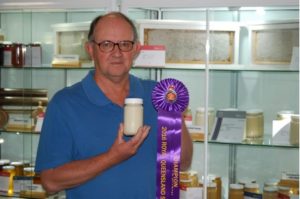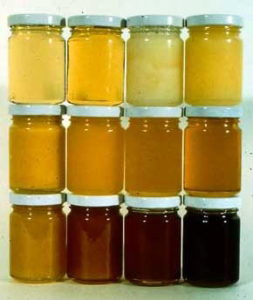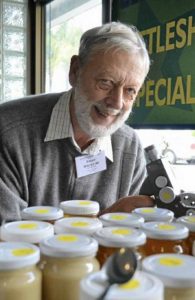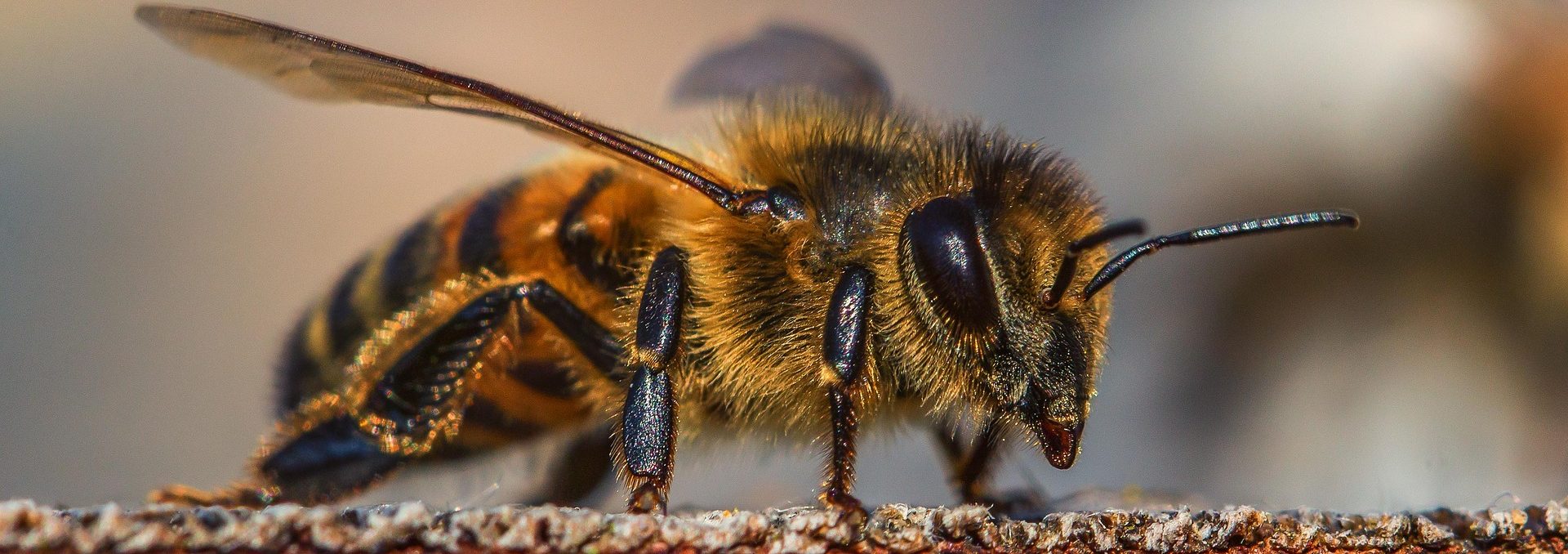Honey Comb in Liquid for Showing
A few members have recently asked about preparing cut comb in liquid for showing or sale. After a little research here are a few tips:
An obvious one first up – you can’t use plastic foundation if you intend to make comb honey.
Some beekeepers put nine frames in a ten-frame box (or seven in an eight-frame box) to get thicker comb.
The best comb is made early in the year, so get the comb honey supers on as soon as the major spring nectar flow begins.
Many beekeepers also freeze comb honey after harvest, a practice that will kill all life stages of wax moths and hive beetles, as long as it is done within a day or two of harvest.
If you freeze the entire frame, be sure to wrap it in plastic before freezing and then leave the plastic in place until the comb is completely thawed. About two days in the freezer should be long enough.
Consider using frames without wires for your cut comb.
If you used a wired frame it is advisable to heat the wires the same way as you do for setting it in foundation to remove them. To remove the wires cut them at the end on the outside of the frame at one end and pull them out from the other end.
Now to cut the comb.
Beekeepers seem to develop their own methods for this, but some of the options I found included –
A normal, very sharp knife with a fine blade so that the comb is cut rather than squashed. Keep the blade clean and perhaps warm it in hot water.
Alternatively, a capping knife was used being careful not to have it too hot or the wax cells melt. This method seemed a little less successful.
The final method I found which appears to be used more for honeycomb being sold, was a square biscuit cutter. Keep it clean and warm it in water but dry it before cutting the comb. I even found one lady who used dental floss to cut comb.
Cut out the section of comb and allow it to drain over a grid ie wire queen excluder. Pieces of wax should drain away so your exhibit has no particles of wax present.
The comb section of honey should fit into the jar through the lid opening, touch the bottom of the jar and have the top finishing so it doesn’t just touch the lid.
Finally, with the comb in place, add liquid honey – the comb honey and liquid honey should be the same colour and floral type.
Showing Honey at Agricultural Shows
By Bruce White ABK

Phil Geeves
Champion Creamed Honey
Several Agricultural Shows have classes for honey, beeswax and queens. While Beekeepers take a lot of pride in handling honey during extracting and in recent years more beekeepers have become producer packers, the majority do not enter the honey they produce in Agricultural Shows.
Entering in Agricultural Shows rewards the competitors by the keen interest shown by the public in the exhibits. Competitors should also get much satisfaction from the prize cards and, if you are a producer packer, these can be used to promote the sale of honey production at farmers markets.
This article is intended to help beekeepers prepare honey for Agricultural Shows, and also to give guidance to stewards or judges involved with Apiculture sections at Agricultural Shows.
Harvesting the honey
The first step that is very important is to select the combs. Newly drawn white combs, fully capped with the desired honey, are selected. If all cells are fully capped the honey is at its maximum density. The combs should be held up with a bright light behind the comb and inspected for any stored pollen. If pollen is present, the comb should be rejected or the pollen cells cut out prior to removing the honey. Pollen must not be mixed with the show honey.
By using a bright light you will also be able to tell if the honey is the same floral type. If it is all the same colour, remove the honey from the combs. The best way to remove the honey for showing is to press the honey from the cells. Uncap the combs then with a clean knife or other suitable instrument and force the honey from the cells. This is the best method of minimizing air entering the liquid honey for competitions.
The other method is to extract the white combs using a small hand extractor. This will avoid the risk of overheating the honey by using no heat during extracting. The extractor should be made of food grade material stainless steel or food grade plastic.
If propolis is on the frame it should first be removed before the frame is placed into the extractor. When removing the honey from the extractor gate or pressed honey, pour the honey down the edge of the settling container to minimize the air bubbles. Honey is hygroscopic and can absorb moisture from the atmosphere. If possible, use a small bucket so it can be filled to the top, or plastic ice cream container: ensure the lid is airtight. Allow the honey to settle for several days, preferable at a temperature of 37C. This will cause any air bubbles, wax or other matter to rise to the surface and these can then be carefully skimmed off the surface.
After the settling.
With the honey at about 37C, pour it down the edge of a cone-shaped nylon strainer. Nylon straining material is available from beekeeping supplies and can be sewn into a cone-shaped bag with the point of the strainer almost touching the bottom of the container. The best container for the straining process is a plastic bucket with a gate at the bottom or an ice cream container. After straining the settled honey carefully remove the strainer. Allow the honey to remain in the straining container for about one week. After a week pour the honey into your show jars by opening the honey gate on the bucket or cut a hole in the bottom of the ice cream container. Vent the lid before pouring, then pour the honey down the inside edge of the jar to minimize air bubbles entering the honey. All jars in an entry should be filled to the same level for uniformity with the honey just not touching the inside of the cap when the jars are level.
Selection of jars is very important. Hold the jars up before filling to ensure there are no flaws from the glass moulding and cull any with imperfections. Equally important is the cleaning of the jars with a quality glass cleaning detergent. The jars must comply with the show schedule, usually 500g glass round jars.
Store the filled jars in a dark location in a closed cardboard box with cardboard bottle partition so the jars don’t touch each other. If stored in a dark location the honey colour is unlikely to change in the short term. When storing liquid honey, granulation can be inhibited by storing at temperatures lower than zero degrees Celsius.
Liquefying granulated honey
This must be done with extreme care to avoid over heating the sugars and darkening the honey colour. Use warm air or a water bath so the honey temperature is kept below 43C. It is preferable to not use reliquefied granulated honey in liquid classes.
Classes
All honey in the same entry should be of the same blend or floral type.
Flavour
Honey should be palatable, free from tang, off-flavour fermentation and acidity.
Density
Honey varies in density: highest points are awarded to the highest density. Density can be determined with a refractometer, rating the buoyancy of the glass rod near the honey surface or by rating the rising of an air bubble by inverting the jar.
Aroma
Honey with a pleasing aroma scores the highest points. Fewer points are awarded for honey with offensive aroma or no aroma, or those with fermentation or over heated. Aroma varies according to the floral source, hence honey from Clover, Stringybark and Yellow Box have their own bouquet.
Clearness
Honey must not have a dull or cloudy appearance, it should be clean and have a sparkle about it.
Brightness
Slightly warm the honey in the jars before showing to increase the brightness. This will remove minute crystals if present and give the entry more brilliance. The honey must be at room temperature for judging.
Comb in Liquid
This is a jar of honey with a cut out section of capped comb placed into the liquid honey in a jar. Prepare the honey as for liquid honey showing except you need to select a comb of honey as you would for showing a frame of capped honey. Using a hot knife, cut out a section of the comb after first pulling out the wires in the frame that held in the comb foundation The comb section of honey should fit into the jar through the lid opening, touch the bottom of the jar and have the top finishing so it doesn’t just touch the lid. The comb honey and liquid honey should be the same colour and floral type. Cut out the section of comb and allow it to drain over a grid ie wire queen excluder. Pieces of wax should drain away so your exhibit has not particles of wax present.
Preparing Granulated Honey
The general requirements are similar to liquid honey. Of major importance is the texture of the granulation and firmness of set.
Evenness of Grain
Classes can be fine or course grain. In the case of fine grain the granules should be fine and almost indistinguishable to the palate and tongue with all the grains even. Floral types such as Lucerne and Clover have natural fine grains. Course grain floral types are usually Eucalypts with the grain larger than the fine grain.
Granulation
To achieve even granulation, 10 to 15 per cent of the selected granulation honey called starter is mixed with the selected liquid honey you wish to granulate. Mix the starter thoroughly with the liquid honey at 18C to 24C until the whole mix is the same colour and consistence incorporation as little air as possible. Leave the mix at 14C for 12 to 36 hours. Before it sets firmly the honey should be poured slowly into the show containers, pouring on the inside of the jars to prevent air bubbles occurring. Store at 14C so the mix will set in about 3 weeks. Best results are obtained if the granulated honey is in firm condition just before showing.
Flavour
The flavour will be determined by the floral source of the starter and liquid honey used in the mix.
Firmness
The mix should set firm but be easy to spread, the starter used will determine this characteristic. Select granulated starter that meets this criteria.
Colour
The colour should be off white to cream, this will be determined by the starter and liquid honey used.
Creaming Honey
Fine-grained starter must be used such as fine-grained granulated honey or save some of the previous batch of the honey you creamed. The colour should be white. The mixing of the starter into the liquid honey is done is such a way to add air to the mix by slow or high speed mixing, using a mincer or motorized stirring method. Creaming machines are available from beekeeping manufacturers, dough-mixing machines can be used or a motorized mincing machine. Don’t use a Mix Master or Kenwood Chef as the honey is too dense and can cause the motor to overheat. It will blow up. With a dough mixer beat the honey until it wont go any whiter, pass the honey through the mincer or a commercial available cream machine until it is white as you can get it.
Preparing Comb Honey
Classes at shows include comb section and frames of honey. The show sections and combs must have new comb that has been brood free. Frames and section are best drawn above the brood chamber with the hive fitted with a queen excluder. A queen excluder reduces the amount of pollen likely to be in the comb or section. Ensure the frames and sections are correctly assembled and fitted with comb foundation.
Colony Section
Closely observe the behaviour of how the bees work on the comb. Select colonies that leave an air space under the cappings, this gives the cappings a whiter colour than colonies that leave no air space. Avoid colonies that collect and deposit a lot of propolis as this could stain the cappings. Remove sections and show combs from colonies that have been on a heavy honey flow as soon as the whole frame or section is completely capped to avoid discolouring of the cappings by bees walking over them. Hold the frame or section with a light behind it to show up any pollen cells, cull these.
Fullness and Colour of the Capping
Highest points are awarded to combs or sections that are well drawn out. cappings should be whitish in colour.
Evenness
All cells that are capped should be even with no depression on the comb surface, capping should all be the same colour, indicating the honey in the comb is from the same floral type. Honey flows that produce light coloured honey are preferred.
General Appearance
The entry should be attractive, it is therefore important to clear the wooden component of the frame or section. Remove any stains and sand paper the wood so it is more attractive. Entries must be shown in a bee proof wooden display case with glass or Perspex sides in the case of frames. Display cases can be purchased to hold a single frame from Beekeeping Equipment Manufacturers.
Pollination
Agriculture depends greatly on the honeybee for pollination. Honeybees account for 80% of all insect pollination. Without such pollination, we would see a significant decrease in the yield of fruits and vegetables.
Pollen
Bees collect around 30 kilos of pollen per year, per hive. Pollen is the male germ cells produced by all flowering plants for fertilization and plant embryo formation. The Honeybee uses pollen as a food. Pollen is one of the richest and purest natural foods, consisting of up to 35% protein.
Honey
Honey is used by the bees for food all year round. There are many types, colours and flavours of honey, depending upon its nectar source. The bees make honey from the nectar they collect from flowering trees and plants. Honey is an easily digestible, pure food. Honey is hydroscopic and has antibacterial qualities.
Beeswax
Secreted from glands, beeswax is used by the honeybee to build honey comb. It is used by humans in drugs, cosmetics, artists’ materials, furniture polish and candles.
Propolis
Collected by honeybees from trees, the sticky resin is mixed with wax to make sticky glue. The bees use this to seal cracks and repair their hive. It is used by humans as a health aid, and as the basis for fine wood varnishes.
Royal Jelly
The powerful, milky substance that turns an ordinary bee into a Queen Bee. It is made of digested pollen and honey or nectar mixed with a chemical secreted from a gland in a nursing bee’s head.
Bee Sting
Although sharp pain and some swelling and itching are natural reactions to a honeybee sting, a small percentage of individuals are highly allergic to bee venom. Honeybees are not aggressive by nature, and will not sting unless protecting their hive from an intruder or are unduly provoked.
The Queen
The queen bee can live for several years. There is only one queen per hive. The queen is the only bee with fully developed ovaries. A queen bee can live for 3-5 years. The queen mates only once with several male (drone) bees, and will remain fertile for life. She lays up to 2000 eggs per day. Fertilised eggs become female (worker bees) and unfertilised eggs become male (drone bees). When she dies or becomes unproductive, the other bees can “make” a new queen by selecting a young larva and feeding it a diet of “royal jelly”.

Peter Warhurst
Honey Judge
Worker Bee
All worker bees are female, but they are not able to reproduce. Worker bees live for 4-9 months during the winter season, but only 6 weeks during the busy summer months (they literally work themselves to death). Nearly all of the bees in a hive are worker bees. A hive consists of 20,000 – 30,000 bees in the winter, and over 60,000 – 80,000 bees in the summer. The worker bee has a barbed stinger that results in her death following stinging, therefore, she can only sting once.
Drone Bee
These male bees are kept on standby during the summer for mating with a virgin queen. Because the drone has a barbed sex organ, mating is followed by death of the drone. There are only 300-3000 drones in a hive. The drone does not have a stinger. Because they are of no use in the winter, drones are expelled from the hive in the autumn.
How Honey is judged at Shows
| Points score Liquid Honey |
Chunk Honey This is a jar of honey with a cut out section of comb |
||
| Flavour | 25 | Appearance | 25 |
| Density | 25 | Colour | 25 |
| Colour | 25 | Flavour | 20 |
| Aroma | 10 | Density | 20 |
| Clearness | 10 | Clearness | 10 |
| Brightness | 5 | ||
| Total | 100 | Total | 100 |
| Granulated Honey | Comb Honey or section | ||
| Evenness of grain | 30 | Fullness | 30 |
| Flavour | 30 | Colour of Cappings | 30 |
| Firmness | 30 | Evenness | 20 |
| Colour | 10 | General Appearance | 20 |
| Total | 100 | Total | 100 |
